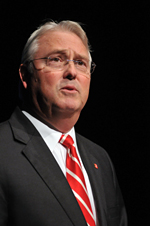Obama: NC State to Lead Clean Energy Institute

In a campus event Jan. 15, President Obama announced that NC State has been selected to lead one of the nation’s most advanced research institutes.
The $140 million Next Generation Power Electronics National Manufacturing Innovation Institute is tasked with perfecting a technology that allows power electronic components to be smaller, faster, more reliable and more efficient than those made with silicon-base semiconductors. This effort could lead to dramatic energy savings for industries and consumers, accelerate the widespread use of electric vehicles and help utility companies integrate renewable energy sources onto the power grid.
The institute’s work will be fueled by $70 million from the U.S. Department of Energy (DOE) and matching funds from the state of North Carolina and the institute’s university and industry partners.

Obama addressed students and other invited guests at the J.W. Isenhour Tennis Center at 1 p.m. Read the White House announcement about the president’s efforts to promote manufacturing innovation. View a video of the president’s remarks.
“NC State couldn’t be more proud to have been selected to lead this new institute, which truly embodies everything that our university stands for – from our ‘Think and Do’ philosophy to our collaborative spirit and commitment to solve the grand challenges of society,” said Chancellor Randy Woodson.
Clean Energy Leader
NC State is recognized as a leader in developing the emerging technology, called WBG or wide bandgap semiconductors. With the creation of the new clean energy institute, the university takes the helm of a research consortium that includes four other universities – Arizona State, Florida State, the University of California at Santa Barbara and Virginia Tech – and 18 energy industry leaders.
Greensboro-based RF Micro Devices, a world leader in the production of power amplifiers for mobile phone handsets, is one of six North Carolina companies in the institute. Several of these companies have links to NC State, including Durham-based Cree Inc., whose innovative LED lighting technology was first developed at the university. Two other industry partners, ABB Inc. and GridBridge, have facilities on Centennial Campus.
The institute will need both industry and university know-how to overcome the technical challenges ahead. Before WBG materials can replace silicon, researchers will have to develop devices and packaging materials that can handle the technology’s higher temperatures and voltages. And they’ll need to redesign current manufacturing systems to integrate WBG devices.

Game Changer
But the payoff could be huge. WBG technology eliminates up to 90 percent of the power losses that occur when converting from alternating current to direct current, and vice versa. It can handle voltages more than 10 times higher than silicon-based devices, greatly enhancing performance in high-power applications. And it can operate at more than twice the temperature of silicon-based devices, resulting in better reliability and efficiency.
“This is going to be a game changer for NC State and for North Carolina,” said Terri Lomax, vice chancellor for research, innovation and economic development.
In fact, the institute’s efforts could foster long-term economic growth in the region and across the nation. WBG semiconductors could transform the nation’s energy industries and give the United States an enormous competitive advantage in electronics, lighting, industrial motors and electric vehicles.
The WBG share of the international lighting market alone will reach $84 billion by 2020, the DOE estimates.
The institute is one of three new innovation hubs announced by the president in his 2013 State of the Union address and part of the National Network for Manufacturing Innovation.
- Categories:


